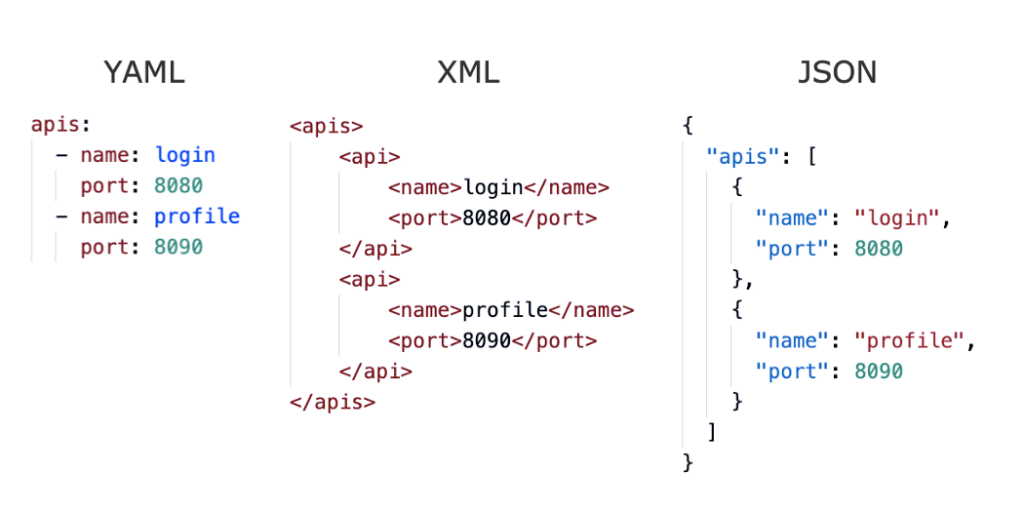|
Getting your Trinity Audio player ready...
|
When I started to learn to code in college, XML was extremely popular for creating web services and SOAP services. However, it was not easy to learn or get used to XML. This led to the popularity of JSON, which was not only easy to pick up and learn but also started integrating well with the RESTful services. Thus, JSON came, conquered XML and started ruling web development.
However, interpreting JSON can be challenging as sometimes it is not that human-readable friendly. Thus, we needed something that could be as similar as JSON but human-readable. Thus YAML was created.
What the heck is YAML?
YAML is a data serialization language that, like JSON, allows you to store information in a human-readable format. It is an abbreviation for “YAML Ain’t Markup Language” (a recursive acronym) that stresses that YAML is for data rather than documents. It may also be combined with other programming languages and also considered a superset of JSON.
YAML is a human friendly data serialization language for all programming languages.
Official documentation
YAML can self-referentially, support complicated data types, incorporate block literals, and support comments, among other things. Recently, YAML is widely used in infrastructure-as-code (IoC) systems such as Helm Charts or Kubernetes to build configuration files or to manage containers in the DevOps pipeline.
YAML Syntax
The structure of a YAML file is a map or a list. YAML uses Python-style indentation to show nesting. Whitespaces are only allowed, hence no tab spaces. There are no standard formatting symbols like braces, square brackets, closing tags, or quotation marks.

The .yml or .yaml extension is used for YAML files.
Syntax Illustration
As already mentioned, YAML (latest release) is a superset of JSON. Hence, YAML is a key-value combination separated by colon and whitespace.
---
# This is a comment for illustrating a YAML file
name: Vivek Naskar
designation: "Software Developer"
age: 29
company: Google
frameworks:
- Spring Boot
- Django
- nodeJs
languages:
java: expert
python: beginner
javascript: proficient
cerifications: |
4 Google certifications
2 Best employee awards
Bachelors in Computer Science & Engineering
# The symbol ">" is used for paragraphs
mission: >
My mission is
to learn newer
technologiesA YAML file usually contains scalars or variables represented by colon and space. Comments can be given by using # at the beginning of a sentence.
A key is always a string, however, the value is a scaler, just like in programming languages such as Python, JavaScript, and Perl. Hence they can be of any data type as an integer, string, float, etc. as shown below.
name: Vivek Naskar
designation: "Software Developer"
age: 29Strings can be specified using the | character, which keeps newlines intact.
cerifications: |
4 Google certifications
2 Best employee awards
Bachelors in Computer Science & EngineeringStrings can also be specified using the > character to print as a paragraph.
mission: >
My mission is
to learn newer
technologiesSequences are data structures that, like a list or an array, store numerous values under the same key.
frameworks:
- Spring Boot
- Django
- nodeJsIn the above snippet, you can also see spaces are used to structure the document in block format. It is simpler to read yet less compact than the flow style.
Uses of YAML
When it comes to developing configuration files for Infrastructure as Code, YAML is a popular choice. These files provide the parameters and configurations for the intended cloud environment.
Docker uses YAML files known as Dockerfiles, which are essentially blueprints for everything required to execute applications, such as codes, runtime, tools, settings, and libraries.
Even Ansible, an automation tool, also uses YAML to construct automation processes. Ansible users write playbooks in YAML code to automate the tedious operations of provisioning and deploying a cloud environment.
YAML files are also used to create Kubernetes resources such as pods, services, and deployments. Heck, you can also create Machine Learning pipelines using YAML.
In Conclusion
YAML is a powerful language and it is so critical to learning. It has a vast range of applications, and we barely scratched the surface. Of course, you can read the complete documentation along with syntax from their official documentation page.
If you liked reading this, then you might also find the below story worth your time.
Helm 101: Brief Introduction To Kubernetes Package Manager
Kubernetes Architecture Explained in Brief
If this article provided you with value, please support my work — only if you can afford it. You can also connect with me on X. Thank you!

